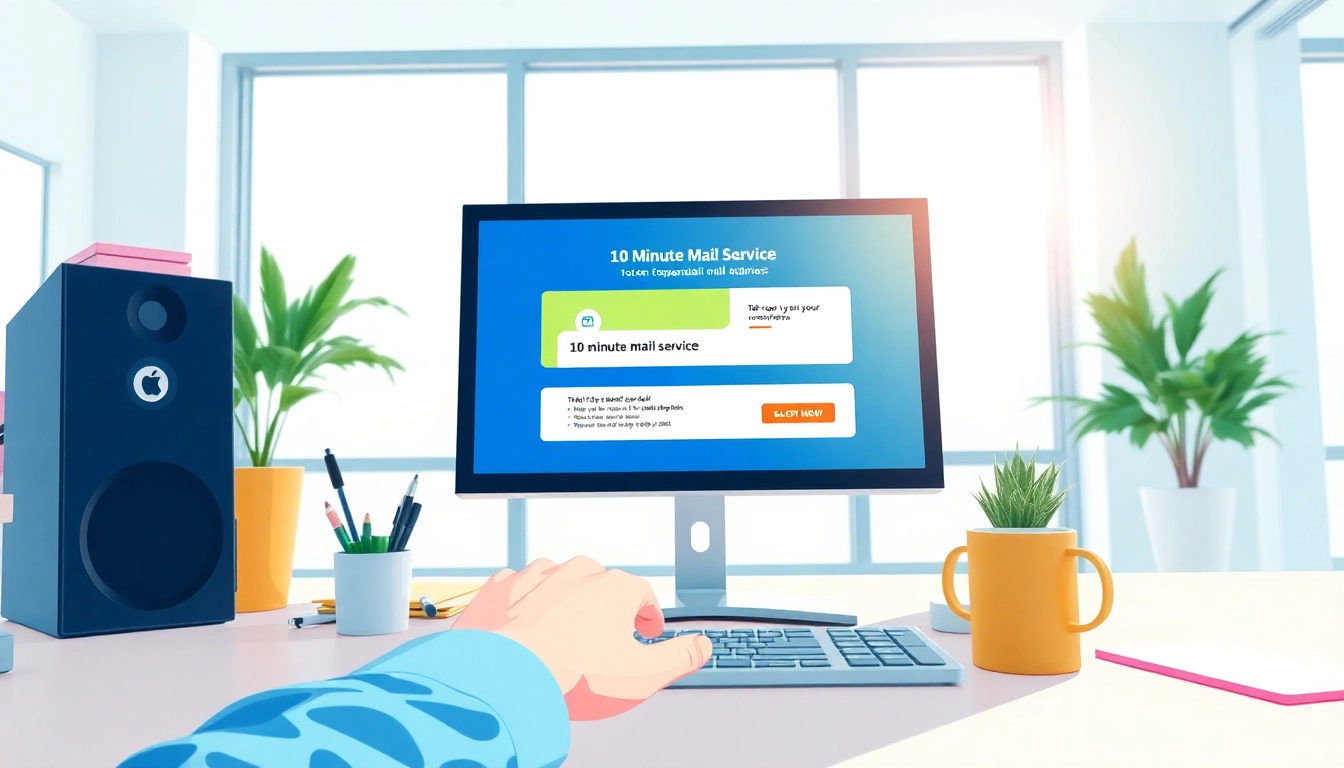Understanding 10 Minute Mail: The Basics
What is 10 Minute Mail?
10 Minute Mail is a free, temporary email service that provides users with a disposable email address for a limited duration, typically 10 minutes. This innovative tool allows individuals to generate an email address that can be used for receiving verification codes, subscriptions, or any other purpose where providing a personal email address might raise privacy concerns. The temporary nature of these email addresses ensures that users can protect their identities and prevent spam from cluttering their primary inbox.
How Does the 10 Minute Mail Service Work?
The process of using a 10 minute mail service is straightforward. When you visit a site offering this service, you’re presented with a temporary email address generated automatically. Here’s how it works:
- Generate a Temporary Address: Upon visiting the website, you typically receive an email address that resembles standard email formats (e.g., [email protected]).
- Use the Address: You can copy and paste this email address wherever needed. For instance, sign up on websites that require email verification or to receive newsletters.
- Receive Emails: Any emails sent to this address will appear on the 10 Minute Mail interface for the next 10 minutes.
- Automatic Deletion: After 10 minutes, the email address will expire, along with all associated emails, ensuring your privacy.
Benefits of Using 10 Minute Mail
The appeal of 10 minute mail lies in its multiple benefits:
- Privacy Protection: It helps maintain your anonymity online by not disclosing your real email address.
- Spam Prevention: By using a temporary email, you can avoid unwanted promotional messages and clutter in your inbox.
- Speed and Convenience: The service allows users to quickly create an email address without any registration or personal information required.
- Easy Access: Users can monitor incoming messages directly on the 10 minute mail interface without needing to configure any settings.
Setting Up Your First 10 Minute Mail Account
Step-by-Step Guide to Using 10 Minute Mail
Getting started with 10 minute mail is a seamless experience. Follow these steps to set up your first temporary email account:
- Visit the service’s website: Search for a provider of 10 minute mail. You can find one such service at 10 minute mail.
- Generate an Email Address: The homepage will show you a generated email address. This is your temporary email for the next 10 minutes.
- Copy and Use the Address: Use the copy button to duplicate this address and then paste it wherever necessary for sign-ups or confirmations.
- Check Incoming Emails: Refresh the browser window to see incoming emails to your temporary address. All messages will appear on the same page.
- Time Management: Keep an eye on the timer. Once the 10 minutes are up, the email address and its messages will vanish permanently.
Common Features of 10 Minute Mail Services
While different services might offer varying interfaces, there are common features that enhance the user experience:
- Timer Display: Most services prominently display the time remaining until the email address expires.
- Email Viewing: A simple interface usually lists all incoming emails in real-time.
- No Registration Required: Users can access these services without the need for signing up, which preserves anonymity.
- Different Domain Names: Some services may allow users to generate email addresses from multiple domain names, giving users a choice.
Tips for Effective Usage of 10 Minute Mail
To maximize the benefits of 10 minute mail, consider the following tips:
- Be aware of expiry: Always be mindful that the temporary email address expires after 10 minutes.
- Use it selectively: Reserve 10 minute mail for sites where privacy is a concern, particularly for promotional emails or verifications.
- Monitor emails actively: Keep refreshing the email window to catch important messages immediately.
- Clear sessions regularly: For additional privacy, use fresh sessions of your web browser when accessing temporary email services.
10 Minute Mail vs. Traditional Email: A Comparison
Privacy Considerations with 10 Minute Mail
One of the most significant distinctions between 10 minute mail and traditional email accounts is privacy. With a traditional email account, you generally have to provide personal information such as your name, phone number, or other identifying details during the registration process. This can lead to the accumulation of spam and the potential for data breaches.
In contrast, 10 minute mail enables you to communicate without disclosing personal information, thereby significantly enhancing your privacy. It’s particularly beneficial for individuals who wish to avoid leaving a digital footprint while interacting with unfamiliar or potentially malicious services.
When to Use 10 Minute Mail Instead of Traditional Email
10 minute mail is ideal in specific scenarios where privacy or quick interactions are necessary, such as:
- Signing up for online services or newsletters that you may not use long-term.
- Receiving verification codes for two-factor authentication without revealing your main email address.
- Testing freebies or trials that require email confirmation.
- Engaging with forums and community sites that mandate an email address for contributions.
Drawbacks of 10 Minute Mail
While 10 minute mail provides many benefits, it’s essential to recognize its limitations:
- Time-Sensitive: The 10-minute limit might not suffice for services requiring ongoing communication.
- No Recovery Options: If you miss messages or need to refer back to them later, that information will be permanently lost once the timer expires.
- Potential Delivery Issues: Some websites may not accept temporary email addresses, viewing them as less trustworthy.
Best Practices for Using 10 Minute Mail Safely
Avoiding Spam and Privacy Issues
To mitigate vulnerabilities while using 10 minute mail, adhere to these best practices:
- Limit Disclosure: Only use disposable emails on websites that are trustworthy; avoid any dubious platforms.
- Prevent Phishing Scams: Be cautious if a site tries to get sensitive information after email verification.
- Use Multiple Services: To protect your privacy further, consider using different temporary email providers to avoid link trails.
Using 10 Minute Mail for Account Verification
Using a temporary email for account verification can streamline the registration process. When engaging with platforms that require a quick sign-up, follow these guidelines:
- Create Your Temporary Address: Use your preferred 10 minute mail service to generate an email.
- Sign Up with the Temporary Address: When required to enter your email address, paste the copied temporary address.
- Retrieve Verification Codes: Monitor your temporary inbox for any verification emails needed to complete your registration.
Ensuring Security When Using 10 Minute Mail
While 10 minute mail enhances privacy, following these security measures can further safeguard your interactions:
- Utilize HTTPS Sites: Ensure that you’re using secure connections when visiting the temporary mail service.
- Don’t Combine with Critical Accounts: Avoid using 10 minute mail addresses for vital accounts or sensitive transactions.
- Clear Browser History: After using, clear your browser’s cookies and cache to ensure that no remnants of your temporary mail usage remain.
Advanced Applications of 10 Minute Mail
Using 10 Minute Mail for Business Transactions
Interestingly, 10 minute mail can be an asset even in business contexts. Here are a few scenarios for its practical application:
- Client Engagements: Businesses can use disposable emails for quick communications related to one-time deals or consultations.
- Testing Services: When testing new services or software tools that require an email, businesses can use temporary addresses to avoid spamming the company inbox.
- Market Research: Gather insights without the hassle of unsolicited follow-ups post-surveys by using temporary email addresses while engaging with consumers.
10 Minute Mail for Privacy-Conscious Users
For privacy advocates and users that are more security-aware, 10 minute mail serves as an essential tool in protecting their online identity. Here’s how:
- Anonymized Sign-Ups: Engaging in forums, social media, and other platforms while maintaining anonymity is easy with temporary emails.
- Multiple Accounts: If a user needs to create several accounts on the same platform, using different disposable emails prevents aggregation of personal data.
- Reduced Digital Footprint: Limiting permanent address usage helps users cultivate a cleaner online footprint.
Future of Temporary Email: Trends and Predictions
The sphere of online privacy continues to evolve with increasing concerns over data security. The future of services like 10 minute mail may see enhanced features and capabilities. Potential trends include:
- Integration with Other Privacy Tools: Applications may soon allow linking temporary emails directly with VPNs or other anonymity tools.
- Extended Lifetime Options: Users may find options to extend the lifespan of temporary URLs beyond 10 minutes for specific services.
- AI Filters: Incorporating AI for smarter filtering of malicious emails to ensure better user experiences.


